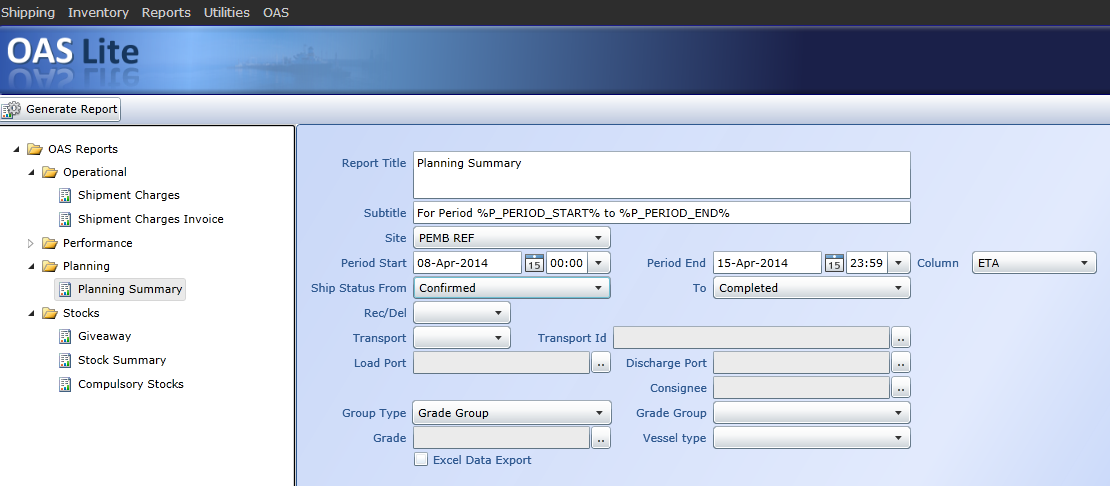
|
Report Technology
The OAS Reporting framework has been designed to provide a flexible reporting system supporting Maron and user derived reports. The user interface provides a navigable tree of reports. Each report has an associated list of controls that enable the user to select values from lists, etc. to filter OAS data presented in the report. The Reporting utility is an integrated part of OASLite and is found as an option off the OASLite main menu.
An OAS report may, subject to configuration, be rendered to the screen, printed or exported as raw data directly to an Excel workbook. Alternatively, the rendered report may be exported to a number of different formats e.g. PDF, XLS, RTF, XML using the in-built export option within the OAS reporting viewer.
Interaction with selection criteria is provided via a library of standard controls connected to the OAS database. The controls dynamically form part of the user interface used to control the report. For example, adding the Tank List control to the report configuration will include a populated list of tanks to the UI without any programming. Consequently, new reports are easily added to the existing library by clients and\or Maron Systems.
Standard OAS Reports are available for performance improvement and management reports in areas that are known to be common requirements for many OAS sites. Local OAS reports may be written as variations of the standard reports, or for other site-specific purposes.
Report configuration is retrieved from the database and displayed within the OAS Reporting User Interface. The configuration controls:
The user will select the appropriate report control values and instruct the reporting system to render the report to the screen (Printed) or exported directly to Excel (Exported). The data provider is used to collect the data from the database from where it is passed to:
Reports may be 'cloned' to create a duplicate for which different default values may be assigned. The following is a typical example of the client configured report criteria selection user interface.

An OAS report may, subject to configuration, be rendered to the screen, printed or exported as raw data directly to an Excel workbook. Alternatively, the rendered report may be exported to a number of different formats e.g. PDF, XLS, RTF, XML using the in-built export option within the OAS reporting viewer.
Interaction with selection criteria is provided via a library of standard controls connected to the OAS database. The controls dynamically form part of the user interface used to control the report. For example, adding the Tank List control to the report configuration will include a populated list of tanks to the UI without any programming. Consequently, new reports are easily added to the existing library by clients and\or Maron Systems.
Standard OAS Reports are available for performance improvement and management reports in areas that are known to be common requirements for many OAS sites. Local OAS reports may be written as variations of the standard reports, or for other site-specific purposes.
Report configuration is retrieved from the database and displayed within the OAS Reporting User Interface. The configuration controls:
- presentation of the reports navigation tree
- selected subset of the reporting controls library to enable the user to filter reported data
- default values for controls specified for the report e.g. date ranges, status values
The user will select the appropriate report control values and instruct the reporting system to render the report to the screen (Printed) or exported directly to Excel (Exported). The data provider is used to collect the data from the database from where it is passed to:
- The Reporting Engine to perform and report specific processing e.g. localised totalising before rendering
- The OAS Native Excel Exporter for a data export directly to an Excel workbook
Reports may be 'cloned' to create a duplicate for which different default values may be assigned. The following is a typical example of the client configured report criteria selection user interface.
